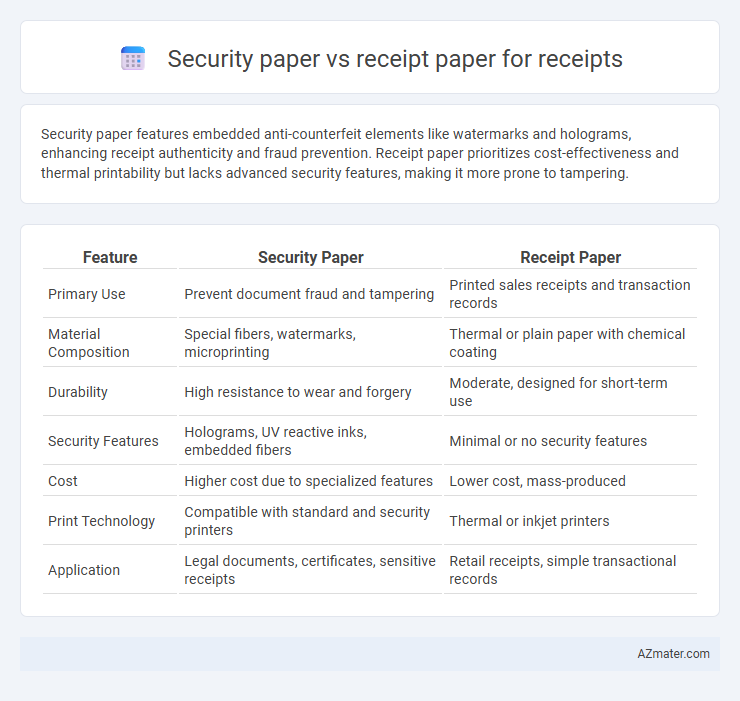Security paper features embedded anti-counterfeit elements like watermarks and holograms, enhancing receipt authenticity and fraud prevention. Receipt paper prioritizes cost-effectiveness and thermal printability but lacks advanced security features, making it more prone to tampering.
Table of Comparison
| Feature | Security Paper | Receipt Paper |
|---|---|---|
| Primary Use | Prevent document fraud and tampering | Printed sales receipts and transaction records |
| Material Composition | Special fibers, watermarks, microprinting | Thermal or plain paper with chemical coating |
| Durability | High resistance to wear and forgery | Moderate, designed for short-term use |
| Security Features | Holograms, UV reactive inks, embedded fibers | Minimal or no security features |
| Cost | Higher cost due to specialized features | Lower cost, mass-produced |
| Print Technology | Compatible with standard and security printers | Thermal or inkjet printers |
| Application | Legal documents, certificates, sensitive receipts | Retail receipts, simple transactional records |
Understanding Receipt Paper and Security Paper
Receipt paper is typically coated with thermal or plain paper designed for quick, cost-effective printing, ideal for everyday transactions. Security paper incorporates additional features such as watermarks, holograms, or chemical-sensitive coatings to prevent forgery and ensure transaction authenticity. Understanding the distinctions between these papers is crucial for businesses prioritizing fraud prevention and document verification in receipt management.
Key Features of Security Paper
Security paper for receipts incorporates embedded watermarks, UV fibers, and chemical-sensitive coatings to prevent forgery and alteration, ensuring document authenticity. Its durability resists tampering, fading, and environmental damage, making it ideal for legal and financial transactions. Compared to standard receipt paper, security paper significantly enhances fraud prevention and compliance with regulatory standards.
Characteristics of Standard Receipt Paper
Standard receipt paper is typically thermal paper that reacts to heat to produce printed text without ink, characterized by its smooth texture and varying thickness usually between 55 to 80 GSM. Security paper, on the other hand, incorporates features such as watermarks, microtext, or holograms to prevent forgery but is seldom used for everyday receipts due to higher costs. Receipt paper prioritizes cost-efficiency and print clarity, while security paper emphasizes anti-counterfeit measures for sensitive transactions.
Security Paper: Enhanced Fraud Protection
Security paper for receipts offers advanced fraud protection by incorporating features such as watermarks, microtext, and UV-sensitive inks that are difficult to replicate. These anti-counterfeiting measures significantly reduce the risk of receipt tampering, ensuring transaction authenticity and safeguarding consumer and merchant interests. Unlike standard receipt paper, security paper provides a reliable solution for businesses that require high-integrity documentation and fraud prevention.
Cost Comparison: Security Paper vs Receipt Paper
Security paper typically incurs higher costs than standard receipt paper due to specialized features such as watermarks, anti-copy technology, and tamper-evident coatings that enhance fraud prevention. Receipt paper is generally more affordable, designed for everyday transactional use without advanced security elements, making it economically suitable for high-volume printing. Businesses must weigh the premium expense of security paper against the risk mitigation benefits when selecting receipt materials for point-of-sale systems.
Print Quality and Durability Differences
Security paper for receipts features enhanced print quality with specialized coatings that resist fading, smudging, and tampering, ensuring lasting legibility and fraud prevention. Receipt paper, typically thermal paper, offers high-quality print clarity but is more susceptible to heat and light damage, leading to quicker degradation and loss of information. Durability in security paper is superior due to embedded security features like watermarks and chemical-sensitive fibers, making it ideal for official documents requiring long-term preservation.
Common Uses for Receipt Paper
Receipt paper is primarily used for everyday transactions in retail stores, restaurants, and service industries due to its affordability and compatibility with thermal printers. Security paper, embedded with features like watermarks and security fibers, is preferred for high-value transactions or official receipts to prevent fraud and ensure authenticity. Common uses of receipt paper emphasize quick printing and customer record-keeping, while security paper focuses on enhancing document integrity in financial and legal environments.
Best Applications for Security Paper
Security paper is ideal for receipts requiring fraud prevention, such as financial transactions, legal documents, and medical billing, due to its anti-counterfeiting features like watermarks and tamper-evident coatings. Receipt paper is best suited for everyday retail purchases and low-risk transactions where cost-efficiency and fast printing are priorities. Employing security paper enhances the authenticity and integrity of documents in high-value or sensitive receipt applications.
Environmental Impact: Security vs Receipt Paper
Security paper often contains chemical coatings, watermarks, and embedded fibers that enhance durability but increase environmental impact due to complex manufacturing and limited recyclability. Receipt paper, typically thermal paper, uses chemical developers like BPA or BPS which pose environmental hazards during production and disposal, contributing to pollution and landfill contamination. Choosing recycled or BPA-free receipt options can reduce ecological footprints compared to conventional security or thermal papers.
Choosing the Right Paper for Your Business Needs
Security paper offers enhanced protection against fraud with features like watermarks and tamper-evident elements, making it ideal for sensitive financial documents. Receipt paper, often thermal or carbonless, is cost-effective and designed for daily transaction records but lacks advanced security features. Selecting the right paper depends on your business's need for fraud prevention versus cost-efficiency and transaction volume.

Infographic: Security paper vs Receipt paper for Receipt
 azmater.com
azmater.com